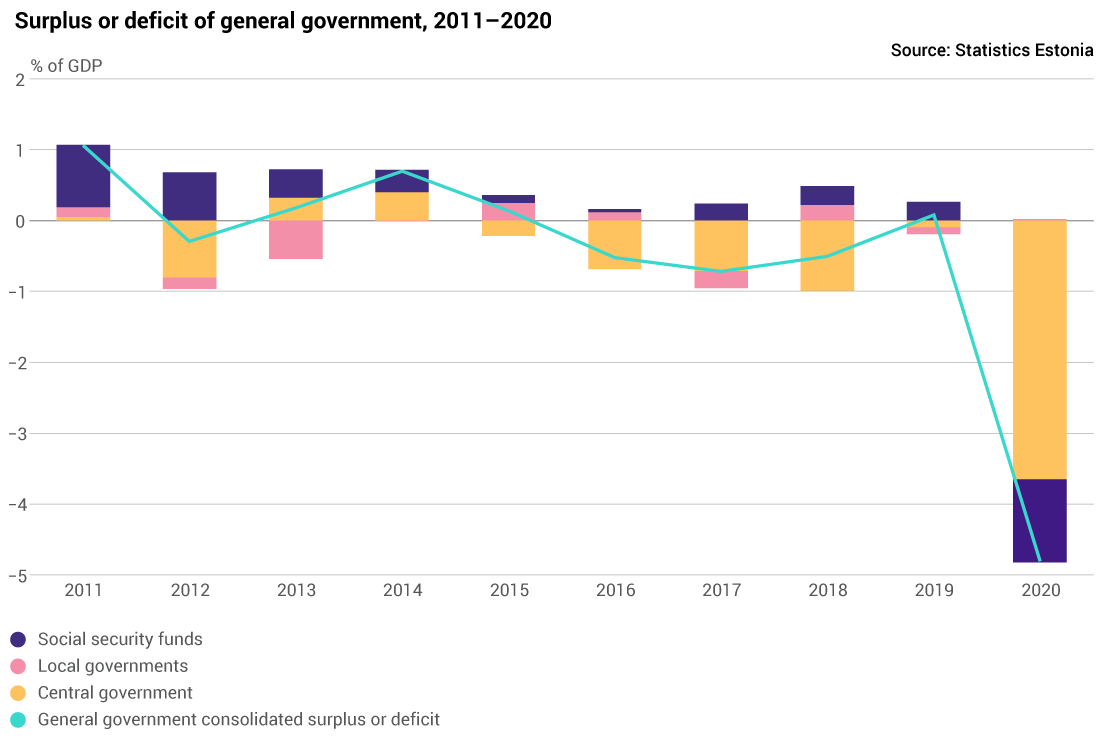General government budget is in deficit, debt doubled in a year
According to the preliminary data of Statistics Estonia, in 2020, the Estonian general government deficit was 4.8% and the gross debt level was 18% of the gross domestic product. At the end of 2020, the general government consolidated expenditures exceeded the revenues by 1.3 billion euros.
In Estonia, the general government sector comprises three sub-sectors: central government, local governments and social security funds. According to Evelin Ahermaa, leading analyst at Statistics Estonia, last year, expenditures exceeded revenues both for central government and for social security funds; their deficits were respectively 991 and 320 million euros. “In 2020, the situation of the general government was considerably less favourable than the year before. The rapid growth in expenses was primarily due to coronavirus-related measures, such as support. In the case of local governments, however, revenues surpassed expenditures and their budget surplus was 5.6 million euros,” said Ahermaa.
The general government consolidated debt* (Maastricht debt) amounted to nearly 5 billion euros by the end of 2020. Maastricht debt doubled compared to 2019 and was at its highest of the last 20 years. At the same time, Estonia’s debt level is significantly lower than the upper limit of the Maastricht criterion. Both the central government and local government debt increased. Long-term loan liabilities grew by 38% year on year.
The central government consists of state budget units and extra-budgetary funds, foundations and legal entities governed by public law. The central government gross debt was 4.9 billion euros, of which 802 million euros were liabilities towards social security funds. The share of foreign debt, i.e. liabilities towards the rest of the world, in the central government’s loan liabilities increased to 66%. Foreign debt increased due to the issuance of long-term securities and loan taken from the Nordic Investment Bank. The volume of long-term securities of the central government increased substantially, totaling 1.5 billion euros at the end of the year. Short-term securities were also issued, and their volume at the end of the year was 425 million euros.
The local government sub-sector comprises city and rural municipality administrations with their subsidiary units and foundations. The sub-sector’s consolidated debt grew by 16% in 2020 compared to 2019 and was 876 million euros. The volume of long-term securities dropped by 17% and loan liabilities increased by 21% year on year.
Social security funds, i.e. the Estonian Health Insurance Fund and Estonian Unemployment Insurance, did not contribute to the general government debt.
* General government debt, or Maastricht debt, is the liabilities of the general government units in the following categories: currency and deposits, debt securities and loans. It is measured as a share of the gross domestic product (GDP). The general government debt shows how much the state has borrowed and to what extent it holds the funds of other units.
The name derives from Maastricht criteria, which among else stipulate the general government debt limit for candidate countries to join the Eurozone (the debt must not exceed 60% of GDP). The debt is calculated without interest liabilities.
See also the government finance section on our website.
More detailed data have been published in the statistical database.
For further information:
Kadri Kütt
Media Relations Manager
Marketing and Dissemination Department
Statistics Estonia
Tel +372 625 9181
